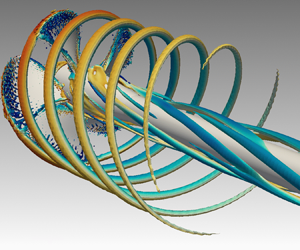Crossref Citations
This article has been cited by the following publications. This list is generated based on data provided by
Crossref.
Zhao, Wei-wen
Pan, Zhi
Yu, Lian-jie
and
Wan, De-cheng
2022.
An overview of flow field computational methods for hydrodynamic noise prediction.
Journal of Hydrodynamics,
Vol. 34,
Issue. 6,
p.
994.
Hilo, Ali Kareem
Hong, Ji-Woo
Kim, Ki-Seong
Ahn, Byoung-Kwon
Lim, Gu-Sub
and
Shin, Suyoung
2022.
Experimental study on the flow patterns and acoustic characteristics of surface piercing cylinders.
Ocean Engineering,
Vol. 259,
Issue. ,
p.
111895.
Di Mascio, A.
Dubbioso, G.
and
Muscari, R.
2022.
Vortex structures in the wake of a marine propeller operating close to a free surface.
Journal of Fluid Mechanics,
Vol. 949,
Issue. ,
Petris, Giovanni
Cianferra, Marta
and
Armenio, Vincenzo
2022.
A numerical method for the solution of the three-dimensional acoustic wave equation in a marine environment considering complex sources.
Ocean Engineering,
Vol. 256,
Issue. ,
p.
111459.
Xiong, Ziying
Rui, Wei
Lu, Linzhang
Zhang, Guoping
and
Huang, Xun
2022.
Experimental investigation of broadband thrust and loading noise from pumpjet due to turbulence ingestion.
Ocean Engineering,
Vol. 255,
Issue. ,
p.
111408.
Rocca, Andrea
Cianferra, Marta
Broglia, Riccardo
and
Armenio, Vincenzo
2022.
Computational hydroacoustic analysis of the BB2 submarine using the advective Ffowcs Williams and Hawkings equation with Wall-Modeled LES.
Applied Ocean Research,
Vol. 129,
Issue. ,
p.
103360.
Petris, Giovanni
Cianferra, Marta
and
Armenio, Vincenzo
2022.
Marine propeller noise propagation within bounded domains.
Ocean Engineering,
Vol. 265,
Issue. ,
p.
112618.
Hieke, M.
Sultani, H.
Witte, M.
von Estorff, O.
and
Wurm, F.-H.
2022.
A workflow for hydroacoustic source analyses based on a scale-resolving flow simulation of a hubless propeller.
Ocean Engineering,
Vol. 261,
Issue. ,
p.
112131.
Posa, A.
Broglia, R.
and
Felli, M.
2022.
Acoustic signature of a propeller operating upstream of a hydrofoil.
Physics of Fluids,
Vol. 34,
Issue. 6,
Posa, Antonio
Felli, Mario
and
Broglia, Riccardo
2022.
The signature of a propeller–rudder system: Acoustic analogy based on LES data.
Ocean Engineering,
Vol. 259,
Issue. ,
p.
112059.
Posa, A.
and
Broglia, R.
2022.
Influence by the hub vortex on the instability of the tip vortices shed by propellers with and without winglets.
Physics of Fluids,
Vol. 34,
Issue. 11,
Posa, Antonio
Broglia, Riccardo
Felli, Mario
Cianferra, Marta
and
Armenio, Vincenzo
2022.
Hydroacoustic analysis of a marine propeller using large-eddy simulation and acoustic analogy.
Journal of Fluid Mechanics,
Vol. 947,
Issue. ,
Posa, A.
Felli, M.
and
Broglia, R.
2022.
Influence of an upstream hydrofoil on the acoustic signature of a propeller.
Physics of Fluids,
Vol. 34,
Issue. 4,
Posa, A.
and
Broglia, R.
2023.
Influence of the load conditions on the acoustic signature of a tip-loaded propeller with winglets.
Physics of Fluids,
Vol. 35,
Issue. 4,
Posa, A.
Felli, M.
and
Broglia, R.
2023.
Acoustic far field of a propeller working in the wake of a hydrofoil.
Physics of Fluids,
Vol. 35,
Issue. 12,
Posa, Antonio
Broglia, Riccardo
Balaras, Elias
and
Felli, Mario
2023.
The acoustic signature of a rudder in the wake of a propeller: Comparison between infinite and semi-infinite approximations.
International Journal of Heat and Fluid Flow,
Vol. 104,
Issue. ,
p.
109236.
Chen, Yung-Wei
Pan, Cheng-Cheng
Lin, Yi-Hsien
Shih, Chao-Feng
Shen, Jian-Hong
and
Chang, Chun-Ming
2023.
Acoustic Field Radiation Prediction and Verification of Underwater Vehicles under a Free Surface.
Journal of Marine Science and Engineering,
Vol. 11,
Issue. 10,
p.
1940.
Posa, A.
2023.
Comparison between the acoustic signatures of a conventional propeller and a tip-loaded propeller with winglets.
Physics of Fluids,
Vol. 35,
Issue. 2,
Posa, A.
Broglia, R.
Balaras, E.
and
Felli, M.
2023.
The acoustic signature of a propeller–hydrofoil system in the far field.
Physics of Fluids,
Vol. 35,
Issue. 7,
Petris, Giovanni
Cianferra, Marta
and
Armenio, Vincenzo
2024.
Full Acoustic Analogy of the fluid-dynamics noise of an immersed cube.
Ocean Engineering,
Vol. 300,
Issue. ,
p.
117433.
